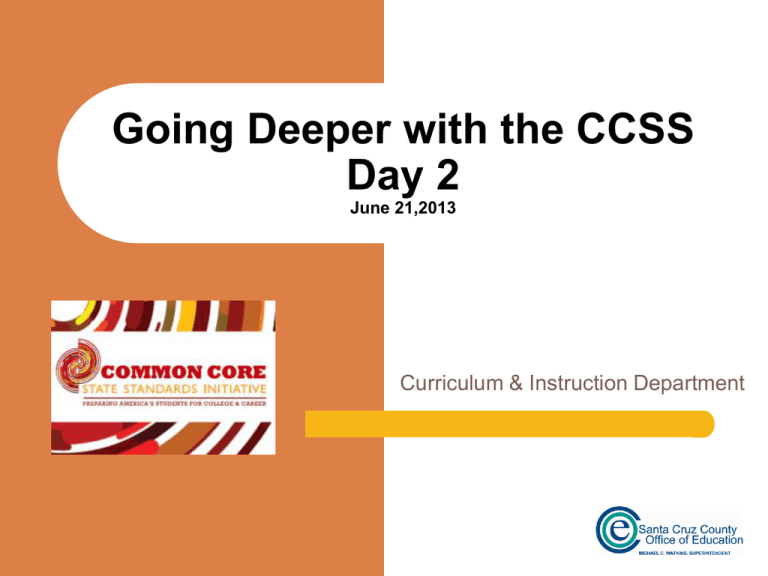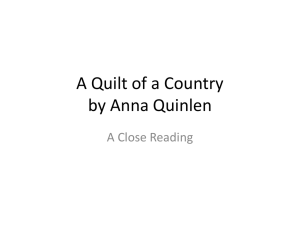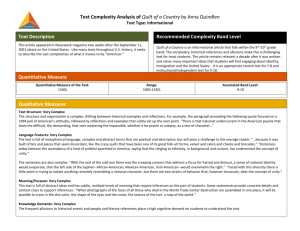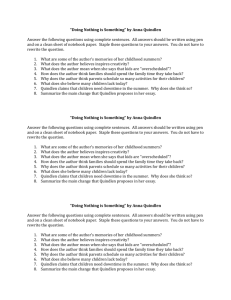Day2_Going_Deeper_with_the_CCSS
advertisement

Going Deeper with the CCSS Day 2 June 21,2013 Curriculum & Instruction Department Leadership is…. Re-Cap of Day 1 Text Complexity (RS. 1 & 10) – – – Structured Collaborative Conversations (LS.1) – – – Text Sets: Non-Fiction or Fiction Essential Question: Reading with a Purpose Close Reading: Marking the Text, Cornell Notes Think, Pair, Square Socratic Seminar Interactive Triads Argument/Opinion Writing (W.1) – – – Stop and Jot Flash Draft On Demand or Extended Day Writing Today’s Agenda Text Dependent Questions Project Based Learning Lunch Gradual Release of Responsibility – Lesson Planning Project & Planning Share-out Text Dependent Questions and the CCSS Doug Fisher on Text-Dependent Questions and Creating a Close Reading Text-dependent Questions Answered through close reading Evidence comes from text, not information from outside sources Understanding beyond basic facts Not recall! Courtesy of Fisher and Frey Which of the following questions require students to read the text closely? 1. 2. If you were present at the signing of the Declaration of Independence, what would you do? What are the reasons listed in the preamble for supporting their argument to separate from Great Britain? Courtesy of Fisher and Frey 1. 2. If you were present at the signing of the Declaration of Independence, what would you do? What are the reasons listed in the preamble for supporting their argument to separate from Great Britain? Courtesy of Fisher and Frey Progression of Text-dependent Questions Whole Across texts Entire text Opinions, Arguments, Intertextual Connections Segments Inferences Paragraph Author’s Purpose Vocab & Text Structure Sentence Key Details Word General Understandings Part Courtesy of Fisher and Frey Annotating/Marking the Text Coding Strategy • Use the Coding Strategy or Marking the Text to read and annotate the essay, “A Quilt of our Country”, by Anna Quindlen General Understandings • Overall view • Sequence of information • Story arc • Main claim and evidence • Gist of passage General Understandings in 9th Grade What is the main idea of the essay? What is her major idea? Anna Quindlen’s “A Quilt of a Country” (2001) Key Details • Search for nuances in meaning • Determine importance of ideas • Find supporting details that support main ideas • Answers who, what, when, where, why, how much, or how many. Key Details in 9th Grade Where are there examples of freedom and oppression? What other juxtapositions does our author use? Anna Quindlen’s “A Quilt of a Country” (2001) Vocabulary and Text Structure • Bridges literal and inferential meanings • Denotation • Connotation • Shades of meaning • Figurative language • How organization contributes to meaning Vocabulary and Text Structure in 9th Grade What role does the word conundrum play in this essay? What is the structure of the essay? How does she build her argument? Anna Quindlen’s “A Quilt of a Country” (2001) Author’s Purpose • Genre: Entertain? Explain? Inform? Persuade? • Point of view: First-person, thirdperson limited, omniscient, unreliable narrator • Critical Literacy: Whose story is not represented? Author’s Purpose in 9th Grade Look at the date of this essay, and then let’s talk about why she might have written it. Whose side of the story is not being told? Anna Quindlen’s “A Quilt of a Country” (2001) Inferences Probe each argument in persuasive text, each idea in informational text, each key detail in literary text, and observe how these build to a whole. Inferences in 9th Grade What does the author believe about the benefits and limitations of tolerance? Anna Quindlen’s “A Quilt of a Country” (2001) Opinions, Arguments, and Intertextual Connections • • • • • • Author’s opinion and reasoning (K-5) Claims Evidence Counterclaims Ethos, Pathos, Logos Rhetoric Links to other texts throughout the grades Arguments in 9th Grade To quote, she says, “These are the representatives of a mongrel nation that somehow, at times like this, has one spirit.” What does that mean and what evidence does she provide for this statement? Anna Quindlen’s “A Quilt of a Country” (2001) Annotating/Marking the Text Coding Strategy • Use the Coding Strategy or Marking the Text to read and annotate the essay, “The Melting Pot”, by Anna Quindlen Intertextual Connections in 9th Grade In what ways does this essay differ from “The Melting Pot,” written by the same author 10 years earlier? Anna Quindlen’s “A Quilt of a Country” (2001) Progression of Text-dependent Questions Whole Across texts Entire text Opinions, Arguments, Intertextual Connections Segments Inferences Paragraph Author’s Purpose Vocab & Text Structure Sentence Key Details Word General Understandings Part Courtesy of Fisher and Frey See Handout on CCRs Progression of Text-dependent Questions Standards Whole Across texts 8&9 Opinions, Arguments, Intertextual Connections 3&7 Inferences 6 Entire text Segments Author’s Purpose Paragraph 4&5 Vocab & Text Structure Sentence Key Details 2 Word General Understandings Part Courtesy of Fisher and Frey 1 Reading with a pencil (Close Reading) As you read, mark the text for evidence that answers the following questions. – What are two events from the text that show ____ is a good leader? (Use biographical document as evidence) – What examples does the text provide of how ____ demonstrates great leadership? (Use famous speech as evidence) – According to the text, how did others view ___as a leader? (Use op-ed piece as evidence) Structured Collaborative Conversations Find a partner with the same text. Use the frames below to discuss the evidence you found in your reading. – Two events that show ____ is a good leader are _____. (Use biographical document as evidence) – ___ showed great leadership when they said, “____”. (Use famous speech as evidence) – According to the opinions of others, ___was ___. (Use op-ed piece as evidence) Don’t overteach. Students with disabilities and English learners have the right to appropriately struggle! Accommodations for Close Reading • Provide students with copies of textdependent questions in advance of reading. • Pre-teach reading, especially background knowledge and cognates. • Provide realia or visual glossaries to support student learning. • Highlight contextual clues. Video Lesson – Using Text Dependent Questions Let’s Practice Use a text of your choosing to develop text-dependent questions. Courtesy of Fisher and Frey Developing Text-dependent Questions for Your Text Do the questions require the reader to return to the text? Do the questions require the reader to use evidence to support his or her ideas or claims? Do the questions move from text-explicit to textimplicit knowledge? Are there questions that require the reader to analyze, evaluate, and create? Courtesy of Fisher and Frey Re-Cap – Addressing the Shifts Text Complexity (RS. 1 & 10) – – – Structured Collaborative Conversations (LS.1) – – – Text Sets: Non-Fiction or Fiction Essential Question: Reading with a Purpose Close Reading: Marking the Text, Cornell Notes, Text Dependent Questions Turn and Talk Interactive Triads Socratic Seminar Argument/Opinion Writing (W.1) – – – Stop and Jot Flash Draft On Demand or Extended Day Writing Common Core is the “What” ... Project Based Learning is the “How” Engage in a rigorous process of inquiry focused on complex, authentic questions and problems Work as independently from the teacher as possible, and have some degree of “voice and choice” Demonstrate in-depth understanding of academic knowledge and skills Apply and practice 21st century skills such as critical thinking, creativity, collaboration, and communication Create products which are presented to a public audience Chinese Proverb Tell Me “I am not unmindful that some of you have come here out of great trials and tribulations. Some of you have come fresh from narrow jail cells. Some of you have come from areas where your quest for freedom left you battered by the storms of persecution and staggered by the winds of police brutality. You have been the veterans of creative suffering. Continue to work with the faith that unearned suffering is redemptive.” Show Me Involve Me 7 Essentials for Project-Based Learning A Need to Know A Driving Question Student Voice & Choice 21st Century Skills Inquiry and Innovation Feedback and Revision Publicly Presented Product http://www.ascd.org/publications/educational_leadership/sept10/vol68/num01/ Seven_Essentials_for_Project-Based_Learning.aspx Project-Based Learning A Need to Know A Driving Question Student Voice & Choice 21st Century Skills Inquiry and Innovation Feedback and Revision Publicly Presented Product The Main Course, Not Dessert “In a typical unit on instruction containing a project […] the teacher covers the main course of study in the usual way, and then a short ‘project’ is served up for dessert. In […] Project Based Learning it is the project that is the main course—it contains and frames the curriculum and instruction” http://www.bie.org/tools/freebies/main_course_not_dessert Online Resource for PBL http://intel.ly/digiconn-pbl An experienced teacher mentors her colleague, sharing her strategies to engage students in projects that enhance their learning. You’ll also see how students are benefiting from Project-Based Approaches. Intel Teach Elements: Project-Based Approaches Module 1: Project Basics Module 2: Project Planning Module 3: Project Assessment Module 4: Project Management Module 5: Project Instruction http://intel.ly/digiconn-pbl Lessons include 3 types of activities 1. E-learning: learn concepts in interactive tutorials 2. Action Planning: apply concepts to one’s own classroom 3. Facilitated Discussion: share ideas and give feedback on action plans Project Assignment Sheet Project Planner http://rubistar.4teachers.org/ PBL Checklist http://pblchecklist.4teachers.org/index.shtml Voki - http://www.voki.com VoiceThread – http://www.voicethread.com VoiceThread – http://www.voicethread.com Xtranormal – http://www.xtranormal.com Lunch Why Do We Need The Common Core? Gradual Release of Responsibility Essential Question Text Sets, TDQ, Cornell Notes Cornell Notes, Socratic Seminar Cornell Notes, Flash Draft, Stop and Jot, Marking the Text Writing over time, PBL Strategies/Concepts Used Essential Questions Stop and Jot Cornell notes Collaborative Conversations Listening with a purpose Socratic Seminar GRR Partner Reading (w/ scaffold) Marking the Text Sentence Frames Flash Draft Text Dependent Questions Project-Based Learning Your Turn to Plan…… Use you GRR Thinking/Planning Template as a guide: – – – – brainstorm/develop possible grade level appropriate topics essential questions Texts to possibly use for text sets activities for teaching argument/opinion writing at your grade level. Be prepared to share out some of your thinking. Planning & Project Share Out Provide the link to your “What is a good leader?” project - http://goo.gl/gwVpW Tell us how you will transform your instruction to meet the expectations of the new standards and deepen understanding for your students. Share – – – Essential Question Text Set Project/Performance Task Description CCSS Update Special Edition: Online Professional Learning Communities The implementation of the Common Core State Standards (CCSS) provides multiple opportunities for educators to engage in professional learning experiences with their colleagues across California and in other states implementing the CCSS. The online educator communities featured below provide a wealth of classroom implementation resources as well as a chance to participate in professional conversations with the larger CCSS implementation community. Register now to benefit from and enrich these California-based and national efforts. CCSS on Brokers of Expertise Brokers of Expertise (BOE) now includes a community group for the CCSS. Here you will find educator resources for implementing the CCSS and an opportunity to participate in an interactive environment where participants may comment on or “favorite” resources. If you are not a BOE member, please sign up and join this vibrant community of California educators. Edmodo Basal Alignment Project and Community The Basal Alignment Project (BAP) builds district capacity to better align existing materials to the English Language Arts and Literacy CCSS while new CCSSaligned materials are developed and published. School districts, publishers, education organizations and others can link to the site or download and adapt materials for us in the classroom. On this site you can learn more about the BAP and how to access these resources. The Illustrative Mathematics Project The project aims to illustrate each of the standards using high quality reviewed tasks from teacher leaders. The site provides guidance to all stakeholders implementing the CCSS by illustrating the range and types of mathematical work that students will experience and other implementation tools, and hosts a community of registered users who develop and evaluate math tasks that illustrate the CCSS. Contributors and advisors to the project include CCSS authors William McCallum, Jason Zimba, and Phil Daro. Share My Lesson Developed by teachers for teachers, this site offers a free platform that gives access to teaching resources and tools and provides an online community for teacher collaboration. The site has a significant collection of CCSS-related resources, covering all the aspects of the standards. Share My Lesson was developed by the American Federation of Teachers and TES Connect.






